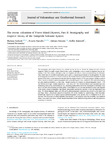Mostrar o rexistro simple do ítem
The Recent Volcanism of Flores Island (Azores), Part II: Stratigraphy and Eruptive History of the Comprida Volcanic System
| dc.contributor.author | Andrade, Mariana | |
| dc.contributor.author | Ramalho, Ricardo | |
| dc.contributor.author | Pimentel, Adriano | |
| dc.contributor.author | Kutterolf, Steffen | |
| dc.contributor.author | Hernández, Armand | |
| dc.date.accessioned | 2023-07-13T17:53:26Z | |
| dc.date.available | 2023-07-13T17:53:26Z | |
| dc.date.issued | 2023-04-20 | |
| dc.identifier.citation | Mariana Andrade, Ricardo Ramalho, Adriano Pimentel, Steffen Kutterolf, Armand Hernández, The recent volcanism of Flores Island (Azores), Part II: Stratigraphy and eruptive history of the Comprida Volcanic System, Journal of Volcanology and Geothermal Research, Volume 438, 2023, 107806, ISSN 0377-0273, https://doi.org/10.1016/j.jvolgeores.2023.107806. (https://www.sciencedirect.com/science/article/pii/S037702732300063X) | es_ES |
| dc.identifier.issn | 0377-0273 | |
| dc.identifier.uri | http://hdl.handle.net/2183/33320 | |
| dc.description.abstract | [Abstract] The stratigraphy and eruptive history of a volcanic system are key to forecast the timing and style of future eruptions. Flores is a small volcanic island in the Azores Archipelago with no record of eruptions since its settlement in the 15th century, although at least six eruptions are known to have occurred during the Holocene. Thus, Flores must be considered potentially active, and its volcanic hazard should not be disregarded. The most recent eruptions clustered at two centres of activity: the Funda Volcanic System (FVS) and the Comprida Volcanic System (CVS). Here, we reconstruct for the first time the eruptive history of CVS, the youngest volcanic system of Flores. Based on detailed tephrostratigraphic and geomorphological work, combined with radiocarbon dating and glass shard geochemistry, we show that – despite featuring five (maybe six) phreatomagmatic craters – CVS was formed in a single volcanic eruption at ∼3180 cal yr BP. This eruption started with Hawaiian-style lava fountaining followed by Strombolian activity, dispersing tephra fallout across the central part of the island. Lava flows were also emitted during the initial phase, which drained to the west and cascaded over the older deposits of the massive slump of Fajãzinha–Fajã Grande, and possibly reached the coastline to form the Fajã Grande lava delta. The initial magmatic phase was followed by phreatomagmatic explosions that formed several maars and tuff rings. Hence, groundwater played an important role in the eruption by transforming a mild Hawaiian-Strombolian eruption into a highly explosive phreatomagmatic event, possibly due to oscillations in the eruption rate. The occurrence of a large landslide contemporary to the eruption, raises the possibility of a combined threat. A new and more robust volcanic hazard assessment for the island involving scientists and civil protection authorities is desirable. | es_ES |
| dc.description.sponsorship | This work was funded by the Portuguese Fundação para a Ciência e a Tecnologia (FCT) I.P./MCTES through national funds (PIDDAC) – UIDB/50019/2020- IDL – and projects IF/01641/2015 MEGAWAVE, PTDC/CTA-GEO/0798/2020 HAZARDOUS. Preliminary fieldwork was also supported by project TH1530/6–1 funded by DFG - The German Research Foundation. MA is funded by FCT through her doctoral grant (SFRH/BD/138261/2018). AH is funded by the Spanish Ministry of Science and Innovation through the Ramón y Cajal Scheme [RYC2020–029253-I] | es_ES |
| dc.description.sponsorship | Portugal. Fundação para a Ciência e a Tecnologia; UIDB/50019/2020 | es_ES |
| dc.description.sponsorship | Portugal. Fundação para a Ciência e a Tecnologia; IF/01641/2015 | es_ES |
| dc.description.sponsorship | Portugal. Fundação para a Ciência e a Tecnologia; PTDC/CTA-GEO/0798/2020 | es_ES |
| dc.description.sponsorship | Deutsche Forschungsgemeinschaft (DFG); TH1530/6–1 | es_ES |
| dc.description.sponsorship | Portugal. Fundação para a Ciência e a Tecnologia; SFRH/BD/138261/2018 | es_ES |
| dc.language.iso | eng | es_ES |
| dc.publisher | Elsevier | es_ES |
| dc.relation | info:eu-repo/grantAgreement/AEI/Plan Estatal de Investigación Científica y Técnica y de Innovación 2017-2020/RYC2020–029253-I/ES/ | es_ES |
| dc.relation.uri | https://doi.org/10.1016/j.jvolgeores.2023.107806 | es_ES |
| dc.rights | Atribución 4.0 Internacional | es_ES |
| dc.rights.uri | http://creativecommons.org/licenses/by/4.0/ | * |
| dc.subject | Ocean island volcano | es_ES |
| dc.subject | Monogenetic volcanism | es_ES |
| dc.subject | Hawaiian-Strombolian eruption | es_ES |
| dc.subject | Phreatomagmatism | es_ES |
| dc.subject | Glass geochemistry | es_ES |
| dc.subject | Holocene volcanism | es_ES |
| dc.title | The Recent Volcanism of Flores Island (Azores), Part II: Stratigraphy and Eruptive History of the Comprida Volcanic System | es_ES |
| dc.type | info:eu-repo/semantics/article | es_ES |
| dc.rights.access | info:eu-repo/semantics/openAccess | es_ES |
| UDC.journalTitle | Journal of Volcanology and Geothermal Research | es_ES |
| UDC.volume | 438 (June 2023) | es_ES |
| UDC.startPage | 107806 | es_ES |
| dc.identifier.doi | 10.1016/j.jvolgeores.2023.107806 |
Ficheiros no ítem
Este ítem aparece na(s) seguinte(s) colección(s)
-
GI-GRICA - Artigos [49]






